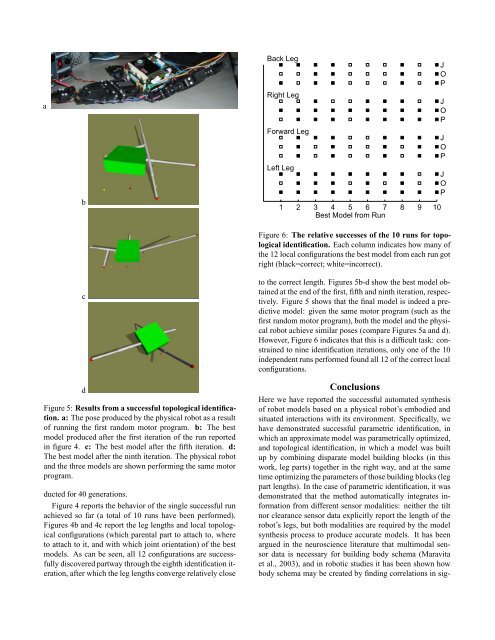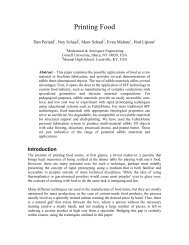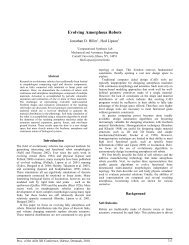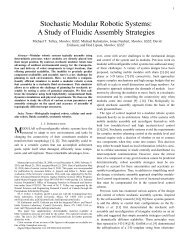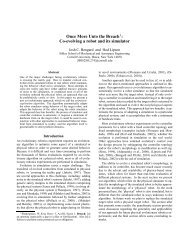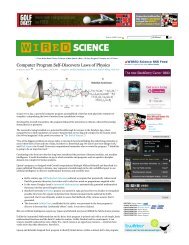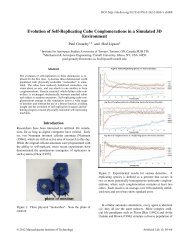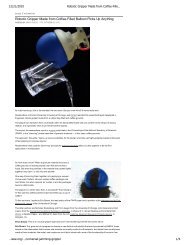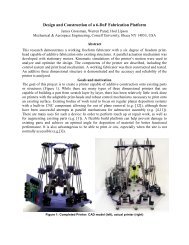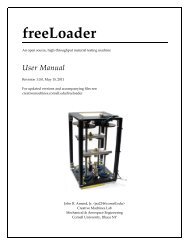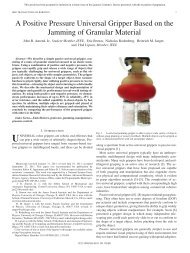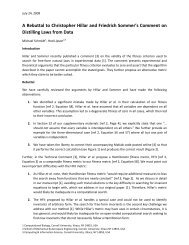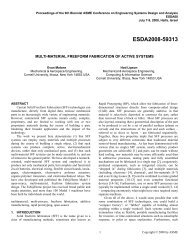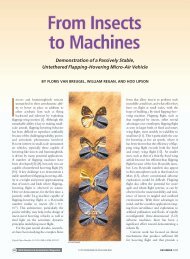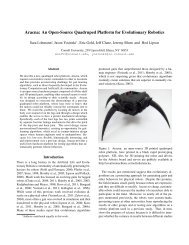Automated Synthesis of Body Schema using Multiple Sensor ...
Automated Synthesis of Body Schema using Multiple Sensor ...
Automated Synthesis of Body Schema using Multiple Sensor ...
Create successful ePaper yourself
Turn your PDF publications into a flip-book with our unique Google optimized e-Paper software.
a<br />
b<br />
c<br />
d<br />
Figure 5: Results from a successful topological identification.<br />
a: The pose produced by the physical robot as a result<br />
<strong>of</strong> running the first random motor program. b: The best<br />
model produced after the first iteration <strong>of</strong> the run reported<br />
in figure 4. c: The best model after the fifth iteration. d:<br />
The best model after the ninth iteration. The physical robot<br />
and the three models are shown performing the same motor<br />
program.<br />
ducted for 40 generations.<br />
Figure 4 reports the behavior <strong>of</strong> the single successful run<br />
achieved so far (a total <strong>of</strong> 10 runs have been performed).<br />
Figures 4b and 4c report the leg lengths and local topological<br />
configurations (which parental part to attach to, where<br />
to attach to it, and with which joint orientation) <strong>of</strong> the best<br />
models. As can be seen, all 12 configurations are successfully<br />
discovered partway through the eighth identification iteration,<br />
after which the leg lengths converge relatively close<br />
Back Leg<br />
Right Leg<br />
Forward Leg<br />
Left Leg<br />
1 2 3 4 5 6 7 8 9 10<br />
Best Model from Run<br />
Figure 6: The relative successes <strong>of</strong> the 10 runs for topological<br />
identification. Each column indicates how many <strong>of</strong><br />
the 12 local configurations the best model from each run got<br />
right (black=correct; white=incorrect).<br />
to the correct length. Figures 5b-d show the best model obtained<br />
at the end <strong>of</strong> the first, fifth and ninth iteration, respectively.<br />
Figure 5 shows that the final model is indeed a predictive<br />
model: given the same motor program (such as the<br />
first random motor program), both the model and the physical<br />
robot achieve similar poses (compare Figures 5a and d).<br />
However, Figure 6 indicates that this is a difficult task: constrained<br />
to nine identification iterations, only one <strong>of</strong> the 10<br />
independent runs performed found all 12 <strong>of</strong> the correct local<br />
configurations.<br />
Conclusions<br />
Here we have reported the successful automated synthesis<br />
<strong>of</strong> robot models based on a physical robot’s embodied and<br />
situated interactions with its environment. Specifically, we<br />
have demonstrated successful parametric identification, in<br />
which an approximate model was parametrically optimized,<br />
and topological identification, in which a model was built<br />
up by combining disparate model building blocks (in this<br />
work, leg parts) together in the right way, and at the same<br />
time optimizing the parameters <strong>of</strong> those building blocks (leg<br />
part lengths). In the case <strong>of</strong> parametric identification, it was<br />
demonstrated that the method automatically integrates information<br />
from different sensor modalities: neither the tilt<br />
nor clearance sensor data explicitly report the length <strong>of</strong> the<br />
robot’s legs, but both modalities are required by the model<br />
synthesis process to produce accurate models. It has been<br />
argued in the neuroscience literature that multimodal sensor<br />
data is necessary for building body schema (Maravita<br />
et al., 2003), and in robotic studies it has been shown how<br />
body schema may be created by finding correlations in sig-<br />
J<br />
O<br />
P<br />
J<br />
O<br />
P<br />
J<br />
O<br />
P<br />
J<br />
O<br />
P


